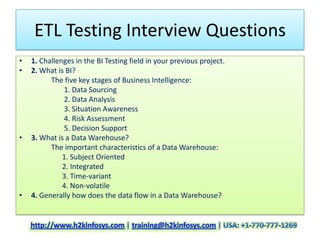
ETL Testing Interview Questions and Answers
- 1. ETL Testing Interview Questions • 1. Challenges in the BI Testing field in your previous project. • 2. What is BI? The five key stages of Business Intelligence: 1. Data Sourcing 2. Data Analysis 3. Situation Awareness 4. Risk Assessment 5. Decision Support • 3. What is a Data Warehouse? The important characteristics of a Data Warehouse: 1. Subject Oriented 2. Integrated 3. Time-variant 4. Non-volatile • 4. Generally how does the data flow in a Data Warehouse?
- 2. ETL Testing Interview Questions • 5. What is a Data Mart? • 6. What is ETL? • 7. BI/DW Testing • 8. What is the need to test a Data Warehouse? • 9. Data Warehouse Testing and Database Testing • 10. Type of testing done in a Data Warehouse project • 11. Who all are involved in testing a data warehouse? • 12. What are the phases undergone by the QA team? • 13. How does the QA team prepare test cases? • 14. Query Format • 15. OLTP • 16. OLAP • 17. Data mining. • 18. Should we use OLTP design for DWH • 19. Lookup tables
- 3. ETL Testing Interview Questions • 20. Real time DWH • 21. CDC • 22. MDM • 23. What are the tools that a QA team may use? 1. Data access tools (e.g., TOAD, WinSQL) are used to analyze content of tables and to analyze results of loads. 2. ETL Tools (e.g. Informatica, Datastage). 3. Test management tool (e.g. Test Director, Quality Center) that maintains and tracks the requirements, test cases, defects and traceability matrix..
- 4. ETL Testing Interview Questions • 20. Real time DWH • 21. CDC • 22. MDM • 23. What are the tools that a QA team may use? 1. Data access tools (e.g., TOAD, WinSQL) are used to analyze content of tables and to analyze results of loads. 2. ETL Tools (e.g. Informatica, Datastage). 3. Test management tool (e.g. Test Director, Quality Center) that maintains and tracks the requirements, test cases, defects and traceability matrix..
- 5. ETL Testing Interview Questions Query format: Attribute check Select count(1) From( Select source table attributes From source table Where list of conditions Except Select corresponding target table attributes From target table Where list of conditions )alias(alternate name) Expected output: Count=0 In the above query, we are first retrieving all the attributes from source table which are mapped to target and then removing from this list all the attributes that are present in target table. So the result count should be zero, meaning that all the attributes that are present in source table are present in target table and the test case can be passed.
- 6. ETL Testing Interview Questions Query format: Duplicate Check Select count(1) From( Select attribute_list_1 From table_1 Where list of conditions Group by attribute_list_1 Having count(1)>1 )alias Expected output: Count=0 In the above query, we are retrieving the attributes which are supposed to be unique and then grouping them in the same order in which they were retrieved. This will group all the records which have these attributes duplicated and so the count will be greater than 1 for such records. When we take the count of such duplicate records and we get zero output, then this shows that there are no duplicate values for unique columns and the test case can be passed.
- 7. ETL Testing Interview Questions Query format: Original Key Check Select count(1) From table Where list of conditions And (any of NOT NULL values are NULL) Expected output: Count=0 In the above query, we are retrieving all the records which have any of the NOT NULL columns as NULL and then taking count of it. If the count is zero, this means there are no such records and the test case can be passed.
- 8. ETL Testing Interview Questions Query format: Reconciliation Check Select count(*) From source table Where list of conditions Select count(*) From target table Where list of conditions Expected output: Source count = Target count In the above check, there are two queries, one fetching the count of total number of records in source table and the other fetching the count of total number of records in target table. If both the counts are same, this means that there are equal number of records in source and target and the test case can be passed.
- 9. ETL Testing Interview Questions Query format: Relationship Check Select count(child_id) From( Select parent_attribute_to_be_checked parent_id, Child_attribute_to_be_checked child_id From( Select distinct attributes from child table Left outer join Select distinct attributes from parent table On join conditions ) ) Where parent_id IS NULL Expected output: Count=0 In the above query, we are retrieving all the records in target table which has no parent in source table and then taking its count. If the count is zero, this means that there are no such records and the test case can be passed. Checking lookup condition is the most common example for this type of check.
